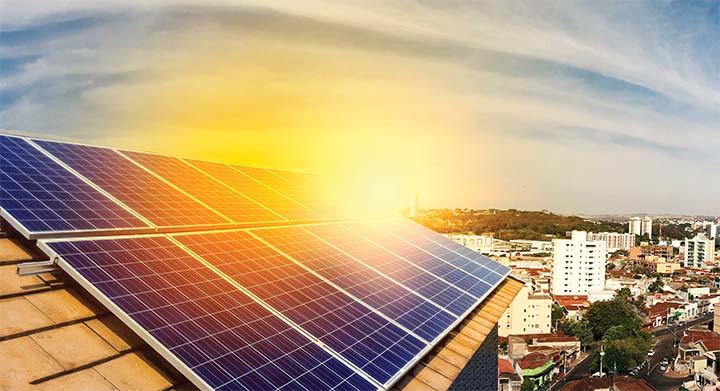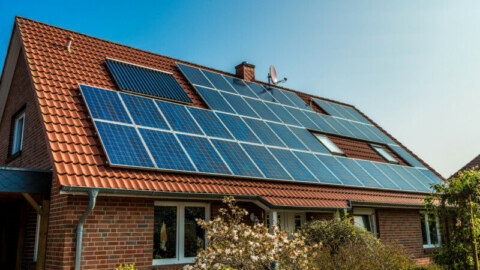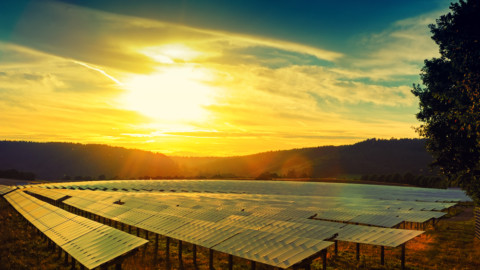By Eliza Booth, Associate Editor, Energy Magazine
Australia now has the highest proportion of household photovoltaic (PV) systems in the world thanks to government rebates and falling costs of installation. But what happens when solar panels reach the end of their energy-producing life and need to be replaced? How do we manage an ever increasing amount of renewable generation waste while still encouraging the uptake of renewable? Energy magazine spoke with Professor Peter Majewski, Research Professor in Advanced Materials at UniSA’s Future Industries Institute, who, along with fellow researchers and industry across Australia, are leading a national push to establish a lifetime stewardship scheme for Australia’s PV industry before it peaks.
With more than 21 per cent of Australian homes – around 2.6 million – now possessing a solar energy system as of December 2020, and many solar farms currently operating or under construction across the country, Australia is leading the world in the uptake of public and private solar energy generation.
And it’s not surprising to see why Australians are so excited about solar energy – our country is the ideal location to reap the benefits from clear solar energy. However, as solar PV panels continue to be installed in homes and across solar farms, a new issue is presenting itself to industry and government – what will we do when these solar PV panels reach the end of their useful life?
Why do we need to recycle?
The popularity of solar PV panels has skyrocketed in recent years with average cost of installation starting from around $3,500, however, prices are steadily coming down even further with demand and production increasing, making them more accessible than ever.
The industry standard lifespan of solar panels made of silicon is around 25 to 30 years, and with the uptake increasing each year, government and industry realised that a peak of PV panels reaching the end of their life is fast approaching.
As PV panels are classified as e-waste, they cannot be disposed of in landfill, meaning that there needs to be a more specialised plan for disposal and recycling in place to properly manage waste.
“People realised, about five years ago maybe, that solar energy is still clean in terms of not producing greenhouse gas emissions, but you will have solid waste at the end of the productive life of the things,” Professor Majewski told Energy magazine.
Professor Majewski said from here the realisation that something needed to be done to prepare for the inevitable peak in renewable generation waste came about from discussions between government, non-government organisations and academics.
The government came on board when it realised the importance of end-of-life management for the waste that would be left over from PV panels.
To assist in the planning of recycling and managing waste, the government added PV technology to the National Waste Policy Action Plan, which outlined the need to implement effective product, stewardship for priority products including batteries and PV systems.
According to Professor Majewski, this was a clear signal to stakeholders that everyone needs to look into waste management and recycling seriously and prepare action plans before the peak.
To achieve this there needs to be strong government backing and legislation to encourage industry to invest in and plan for recycling and waste management of PV panels, otherwise they may disregard this need as something to think about further down the track.
“These product stewardship schemes, or the development of the product stewardship schemes, are usually labelled as industry led. So the government wants the industry to lead the development of the product stewardship scheme in order to ensure that they have a big say,” Professor Majewski explained.
“The product stewardship scheme is set up in a way that it’s not harming or penalising the industry for doing something which everybody wants to have. We have good quality, low price solar PV panels. The industry has to work with the government in order to ensure that the end-of-life management is secure.
“The government wants to have a lot of consultation with manufacturers, with installers, with electricians, and researchers to ensure to get the best product stewardship scheme out of this process, and they are very keen to have a voluntary product stewardship scheme.”
This voluntary scheme would be similar to those already established for other types of e-waste like computers, batteries and electronics, and would encourage collaborative involvement from the industry to tackle the issue.
Where are we at now?
Realising the need for a coordinated approach to recycling and managing solar PV waste is only half the battle, and we are still a ways off in terms of being fully prepared for the peak of waste from these technologies.
So, where does Australia currently sit with managing PV waste and how does it compare to the rest of the word? “In Europe there’s a lot going on. They have big companies involved like Veolia, for example, who are running recycling plants in France for solar PV panels.
Here in Australia we have, I would say, an emerging industry.” Professor Majewski explained that there are multiple different parts of PV panels that can be recycled, such as the solar cells.
However, there are other portions of the panel that are very difficult and environmentally not sound to recycle or repurposed, such as the plastic components, presenting a more difficult issue to solve.
“Not all solar cells in the panels are damaged or destroyed once the panel is not working anymore. You can recover the working cells and build new panels out of it, or smaller panels for different purposes.
“They have some components like plastic or the back sheet – the weatherproof sheet for the panel – which is going to be very difficult to recycle because it’s plastic and there’s very limited scope.”
Although there are components that present more of an issue for waste management than others, that doesn’t mean that there aren’t companies diving into recycling for solar panels already.
In February of 2021, solar panel recycling company Reclaim PV Recycling announced its plans to establish its first solar panel recycling processing facility in the Adelaide suburb of Lonsdale, in South Australia.
The plans estimated that the facility would be able to recycle tens of thousands of PV panels a year. Following this, a new solar panel recycling facility opened in Thomastown in Melbourne’s west by energy co-operative, Lotus Energy.
The facility claims it is able to recycle 100 per cent of end-of-life solar PV modules, saying in a press release in September 2020 that the facility was able to recycle all materials recovered from the PV panels like solar modules, inverters, cables and batteries for alternative use, leaving no waste for landfill.
However, it’s not just PV panels that are testing the ability to be recycled. Another renewable energy generation technology is presenting a challenge for researchers and industry – wind turbines.
The blades of wind turbines are large and notoriously difficult to recycle, being made out of steel and fiberglass, which is banned from landfill.
“These blades are the size of an airliner wing, and they have been built to withstand hurricane-force winds, so they are a big challenge when they get to the end of their life,” Professor Majewski said.
“As with solar panels, that disposal challenge requires planning and preparation, but approached the right way it doesn’t have to be an insurmountable problem, and we are beginning to look at strategies for how to deal with these blades as they come offline.”
Between PV panels and wind turbines, it’s clear that more needs to be done to address the increasing peak of renewable energy waste and ensure our efforts to shift to more sustainable energy generation isn’t at the expense of an increase in waste.
What more needs to be done?
Looking to the future of solar PV panels and recycling, Professor Majewski said that getting the design right at the manufacturing level will be key to ensuring proper disposal at the end of the panels’ life cycle.
This can include making the panels easier to disassemble and also avoiding materials that are not recyclable, like the plastics currently being used, creating a true circular economy in the renewable space. However, Professor Majewski cautions that changing the manufacturing process significantly could be a double-edged sword.
“The future research should move towards design for recycling, so that the design of the panels and manufacturing processes for the panels have in mind that they need to be recycled at one stage, which could include easier assembly of the panels.
If they’re easier assembled, you can more easily disassemble the panels. This helps recycling,” Professor Majewski explained. “There’s research worldwide going on in this area, but as long as the industry doesn’t see a financial benefit of … using new materials or a change in the current manufacturing process, then they wouldn’t do this.
“It’s a situation where a lot of people understand we have to change something in order to make them more recyclable but on the other hand, we don’t want to disrupt the manufacturing and distribution of solar panels because we want to have it in order to reduce the greenhouse gas emissions.”
Hopefully with the proposed stewardship scheme in Australia, recycling, reusing and disposing of PV panels can be undertaken in a more economical and safer way, without disrupting the manufacturing process too greatly.
The ideal outcome for Professor Majewski would be having a scheme that is agreed upon by all stakeholders involved. From here a product stewardship organisation can be developed to overlook operations and ensure that all parties involved are doing the right thing and recycling in the proper ways.
For Professor Majewski, the key to successfully curbing renewable waste is starting the planning now, before the dream of lower emissions turns into a nightmare.
“We have time to plan for this and ensure the processes are in place, but we have to start acting now, as the right practices may take some time to implement,” Professor Majewski said.




















The need to recycle PV systems, or at least modules has been formally accepted by governments and industry since 2016 when the then Environment Minister Greg Hunt put PV on the Product Stewardship priority list.
The progress can mostly be attributed to Sustainability Victoria, and culminated in the “PV Systems Stewardship Options Assessment” report published in March 2019.
After that it all goes dark. Maybe, like ducks on water there is furious action going on out of sight. However, I suspect bureaucracies have done what I have seen happen before, they are happy to arrange consultations, pay consultants to write reports but then stop short of actually doing anything.
In my own field I recall labouring until 3am to finish a lengthy submission within the tight 6 week time frame the Department of Environment allowed us. Seventy Industry submissions, then sat in Canberra for 3 years with no response. (I’ll tell you another time how I got it moving.)
Today, something must now be stirring on the PV recycling front.
At her June address to the National Press Club, Environment Minister Sussan Ley “put the industry in notice” that she needed a coordinated Industry response to the looming landfill catastrophe os solar panels.
Which is an odd thing to say, given panel recycling has been on the agenda since 2016 and Industry peak bodies report that they have made 3 attempts to get a recycling plan in place: each rejected by Sussan Ley’s own Department!
Further, her Department put out an open call for a Partner to develop Product Stewardship in December 2020, closing January 2021.
The day after the National Press Club lunch, we saw that Recycling PV was suddenly elevated to the top of the Product Stewardship priority list. That’s good news at last because we now have a deadline for a result. (scheme design 2022, implementation June 2023)
All I can suggest is that our Minister was ill-informed by her bureaucracy or perhaps is just stirring the pot. Or perhaps pandering to an audience who likes to hear her poking those renewables people.
What hurts is that she inferred to the National Media that our Industry has been slack and is leaving the country with a landfill nightmare, when the truth is that the work has been progressing for years and it is her Department that’s moving at a snail’s pace.